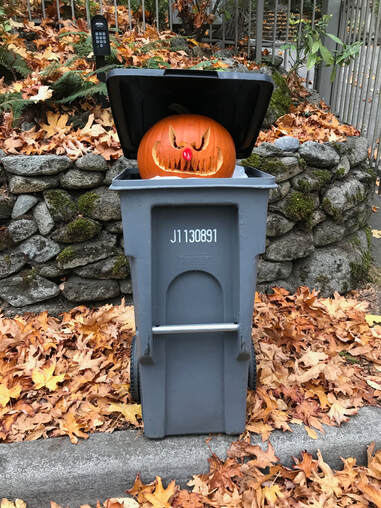 It’s a soft voice, insistent, swirling in my brain like mists on a morning hike after a rainy night. The soundless voice is chilling. I’m alone. The nights here are dark and people are strangers. The world around me seems bigger when darkness comes. Will that bigness pull me into that dark vortex? Last night I flipped on the porch light. The sky became even darker in contrast. A coyote howled on the mesa. Do coyotes howl to express their fear? My fear is a sensation. My chest is tight, my skull prickles. If I relax, the words may come. A Dark Night for my soul This isn't the beginning of a horror story. Even though the dark night before All Souls Day, is soon here, I don’t have a display of pumpkin, mums and ghost lights on my portal. My front yard right off the portal is a disaster zone with empty concrete bags, coffee cup lids and Lacroix cans strewn around among tools left out as a courtyard wall is taking shape. A wall to keep out intruders? No, I don’t carry that fear. A wall to protect plants more delicate than sage brush from harsh, cold spring winds, offer some shade from the intense sunlight. The workers come and go as they please. An air of a local culture of living in the moment, and responding to daily situations at home (trucks break down, the road is muddy, I don’t feel like working today). Weather adds a separate unpredictable dimension. The workers are messy in their operations, but the wall looks good. They know how to stucco. I have no control over this project any more. The voice in my head says, they’re stretching things out. They’re robbing you of your privileged white-woman money. Mind spinning tales of fear. Fear of Belonging Since I’ve moved to a new state, a strange environment, the voice of fear swirls in my brain. What if I don’t belong here? What if I don’t find people with similar values? What if living near family is not what it’s trumped up to be? I step out, join groups, meet people. Time is my enemy. It takes time to build trust, develop relationships that can stand the difficulties of a fast-paced, always changing world. If I stop reaching out, will anyone look for me, reach out? The phantom of aloneness hands me my tricky thoughts of fear. The Great Rift When I arrived in Taos six months ago, I saw the mesa embraced by the Sangre de Cristo mountains. Pueblo Mountain rising in the center of the stretched-out arms like a heart, a bosom from which generosity flows, the Rio Pueblo river cascading to the Rio Grande, below which lies the great rift, the crack in the earth, a doorway to the underworld. The land looked like a woman lying on her back, welcoming me. The river is her lifegiving voice. The crack in the earth is the door to the (under) world of this planet. I’m nearing the time in my life of transition to another world. I don’t fear that transition. The Rio Grande rift is my reminder of what’s coming. Fear of Others It’s not in my bones to sit and wait for things to come. I move, I do, I use my brain. My fears rise when I meet my aloneness in the dark of night, when I feel my vulnerability as winds fly, am reminded of my white privileged status when I meet the others who are not so protected: the ones who are carving out a life on the mesa where land is cheap, water absent, roads are dirt and mud; the ones who live on pueblo land and want to protect their ways and values that rely on spirit and intuition. The spirit of land and sky, and an intuition that won’t fit white men’s regulations. An Era of Fear We live in an era of fear. Politics of fear create division and mistrust. A war full of fear and uncertainty tears apart the world. Those who have been cornered, flee or fight. Hunger and homelessness numbs resistance to policies and terrorism that rob people of their human dignity. The privileged in fear of the tsunami of disasters, violence, and criminality, bar themselves behind the walls of their homes, their gated communities, in privileged neighborhoods. We don’t need Halloween to tickle our fears. Many refugees already have their fears; not just fear appropriate for a Halloween holiday, but gutwrenching fear while waiting to see if they’re welcome in a new land where they don’t speak the language, don’t know the values. Fears of climate change and aging propelled me to make my move. Can I belong in a small community where the poor rely on the rich while resenting them at the same time; where the educated need the natives to teach them how to survive on the land since they themselves have robbed the land in their pursuit of profit. I must wait to see if trusting my intuition that said, “move to a place where spirit will shake your certainties, will help you grow, where family wants to be community”, was a good choice. While waiting, I’m building a wall, cover my vegetable plot and make a small greenhouse; I stack extra firewood. Time to be Still The wood in the Kiva is turning into coals. The bread loaves finished baking and rest on the counter. Pear butter waits on the stove to be put in jars. the season of being inside is around the corner. As the natives say: “it’s the time of being still; the time when mother Earth sleeps”. Outside, the wind has blown the rain clouds away, the sun is out, evaporating the mists of fear. Time for a quiet walk.
2 Comments
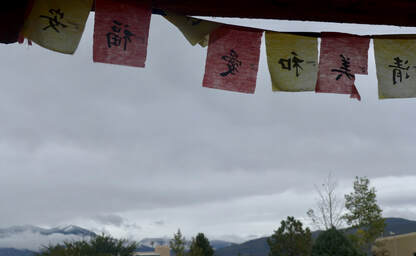 Today is a gray, rainy day in Northern New Mexico. I expect the sun to peek out later in the afternoon; it seems, she always makes an appearance once a day. Living here, the sun has taken a primary place in my life. My Friend the Sun The sun is my loyal friend. I rely on her to lift my mood, greet me early through my bedroom window, and tell me “time to get up; no more lazing around!” Today I have to motivate myself to do something with my day. Living the life of a retiree, it’s easy to slip into puttering around the house, ordering things that don’t need ordering, scrolling social media and news for a dopamine drip, streaming and listening to my favorite radio station 1800 miles away. Yes, there’s local culture, but technology has given me regular, reliable access to friends across the world, access to world renowned programming for entertainment and news. A high-tech shopping industry and UPS or FedEx delivery energy bunnies deliver products I can’t get in this remote part of New Mexico.It doesn’t matter anymore where you live, products you want are available. What we can and can't control Except the weather. The weather still has autonomy. Corporate greed doesn’t control it, the privileged can’t shun the weather. Yes, if you can afford it, you can move to a mild climate where housing is expensive and gated communities offer safety from the less privileged. But, the weather isn’t what it used to be. For the last 50 years, we’ve sent so many CFT’s and CO2 into the atmosphere that things are changing. Weather doesn’t care, it does what it must as temperatures rise in the oceans, causing winds to gather unparalleled strength as we just saw in Florida, bringing unexpected moisture even to this high desert land. We know that hurricanes, wildfires, earthquakes, tsunamis, and flooding do not care if you’re rich and privileged, or poor and living marginally. Weather is the great equalizer. The sunny side of the weather and I have become fast friends. In midlife, I discovered that my moods in winter had a name: Seasonal Affect Disorder or SAD syndrome. I learned that sun exposure made me a happier, more energetic person. I seek the sun and she gives me jolts of happiness as I walk in the outdoors and receive her gift. Creating a day Today I am in charge of my mood. My healthy body had to answer the call of nature and got me out of bed in the grey morning. My long-time daily meditation practice routine put me on my cushion; while I worked on focusing, my mood lifted while I emptied my mind. A cup of black tea followed; it gave me energy for puttering. I fixed the heater in my workout room (it just took new batteries to get things going!). Happy with my success I did a strength-workout while streaming news from afar. Social media check afterward sent me friendly comments from Facebook friends. While it was still raining, I grabbed a ripe avocado and made avocado toast for breakfast, feeling very California “hip” and satisfied. I want to write, was my next thought. The season is changing, my writing season is here. My New Season Writing makes me happy. Like hiking and climbing mountains, writing is type2 fun. You must effort, overcome frustration, admit mistakes, re-do, until you stand on top of the mountain, or the skyline view, a glittering lake, a splash of golden Aspen awe you. You rejoice and feel good in your body. Writing does the same thing for me. I reach deep inside instead of outside. I discover, I am renewed after spending time in a state of “flow”. Flow is a measurable dopamine experience in the brain. So here is my morning blog for you, my reader. I hope you will take charge of your mood, find what gives you energy, makes you happy. I can see snow on top of Mt Wheeler where I climbed last weekend! The grey sky to the east is getting lighter, the rain has slowed to a drip. The sun is burning the clouds that hang over the Pecoris mountains. I bet she’ll show her face soon. An energizer FedEx angel just delivered and helped carry my new, heavy, adjustable craft/sewing/painting table in the box into my studio, so I can put it together. More creativity awaits! Autumn and winter can come. I’m ready to switch between sunny and grey days and keep my mood from plummeting. 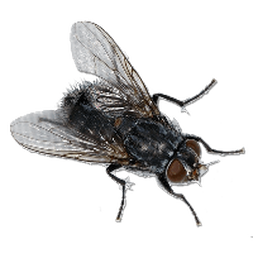 It is day 11 of the meditation retreat I'm attending. I’m sitting on my cushion. Mid morning after breakfast, my energy is still strong and I’m intent on staying focused on breathing and body sensations. Yes, there’s still a desire to enter that effortless state when the boundaries between body experience and mind dissolve and I can enter a state of absorption that feels very much like being in the moment forever. Ah, goals of meditation, the traps of the mind! Focusing The day has warmed up already, and as I did my morning walking meditation in shorts, I sit with bare knees and lower legs. My breathing becomes regular and my attention deepens. Thoughts are fleeting. Yes, there are always thoughts, I think. Isn’t that the point, to notice the thoughts and let them go? Back to the breath, the body. Reactivity The fly lands on my knee, crawls around, flies away. Lands again and walks around my knee. I swat at it and it leaves me alone. For a little while anyway, then the fly is back. My attention is now fully on the fly, not on my breath, but on the tickling sensations the fly is causing. Tickling, tickling. How long can I stand it? The fly leaves, restless being that it is. I’ve taken a vow not to kill during this retreat. Maybe I can catch it, maybe I can cover up and not give it attention. I put a shawl over my knees and for a little while, the fly comes and goes and walks around on my clothes. I open my eyes, see the fly sitting on the shawl, slowly move my hand to cup the fly. No luck, the fly escapes. I wait for it to land again, try again; escape artist, that he is. Since the fly is a living being, maybe if I repeat my loving kindness phrases, the fly will calm down and sit somewhere quietly. The fly lands on my face. Sensation galore! This is too much! I will have to hide from George, which I’ve named this being by now. I pull the shawl over my head, covering my hands and knees and face, with just a little breathing opening. Thoughts of the flies during my first meditation retreat in India float through. Thoughts about the women pulling their saris over their heads. I go off on a tangent of thoughts about head dresses in the Afghan desert. Are all these turbans a way to keep the flies off your face? Back to breathing, back to body sensation, I remind myself. Heat under the shawl, sweat dripping down my face. I observe, I react, not liking what I experience. George finds his way into the crack of my shawl and walks around on my cheek. Well, if it’s going to be like this, then I might as well take the shawl off my head and cool down! I readjust, check my watch, 25 minutes to go to th end of this session. George is gone, it seems, maybe, maybe? I observe my breath, body sensations calm down. I focus. Fly Sensations Soon George is back, on my left cheek, on my eye, my eyelashes. I experience less reactivity, I can handle the eyelashes twitching. George walks along my eyelid and enters the corner of my eye. George stops moving, George stays, I observe and wonder how long? George doesn’t move. What is it about the corner of my eye? Is he drinking from my eye, bathing in the eye liquid? Has he been thirsty, flying around in my house for the last 2 days? Thoughts keep coming, but at least I’m not swatting, reacting, hating this creature. I’m calm, I’m focused on George. Then I have a thought: maybe I can cup my eye with my hand and catch George before he can fly out of the cavity. Slowly, I move my hand. George is still sitting in the corner, inebriated. Lightly, I bring my hand down. I cup the corner of my eye. George flies up, but his wing is under my hand. I’ve caught George!! Slowly I get up, holding my hand over my eye socket, walk outside and let George fly away. I return to my cushion to finish the session. Insight I didn’t kill; I kept a kind attitude; I stayed even-handed. I focused on the sensations at hand and deepened my understanding of what meditation is about. Sometimes insight is delivered by a fly. The 36 Buddhas on the thanka in my meditation corner would make an affirmative hand sign if they could. P.S., I’ve been quick with opening and closing the front door and keeping the flies outside. One session with George is enough. Veering away from the Tuolumne river, I have only 2 miles left to walk in the forest with duff underfoot. 1:00 PM, I know I will finish barring some extraordinary event. My legs move like a machine, left, right, left right. Swinging my arms, I pole my hiking sticks in rhythm. My breathing is easy. Yet, I feel a bone tiredness deep inside. All Things Change Is it my body? Is it my mind? Elation I’ve felt in the last 3 weeks passing through jaw-dropping beauty, cheered on by a super wildflower bloom, up and down rugged passes, has left me. The forest, once a refuge and comrade, is now just a bunch of trees providing shade as I move along. The white granite rocks lining the path in tribal-like groupings, once a delight to touch, rock to lay my body on, are a sprinkling of stones strewn around by an otherworldly force no longer holding me in awe. My last moment with nature was 15 minutes ago, sitting at the bank of the Tuolumne river as it glided over these massive stones toward somewhere unknown, telling me that everything passes. Telling me that all these moments on the trail pass. Reaching the Goal In an hour, I will have hiked 2650 Miles on this trail, year after year in periods of two to five weeks. An hour from now, I can say that I finished hiking the whole Pacific Crest Trail. A goal I set myself 3 years ago as finishing became a possibility if I kept my health, if I could keep up the training, and if I could hold on to the desire. Teachings on the Trail Every year when I hiked a section, the trail taught me something profound. I like profound. I reach for experiences that are transformative. This deepens living. I learned I was not afraid of being alone in Big Nature. I felt connected and free. I learned I can hike with pain and still appreciate my body as it moves through this world. People want to be helpful if you ask. Otherworldly forces in high altitude places got my attention; forces that protected me, forces that guided me, that told me what was in my future. Forces I don’t understand, but certainly can’t ignore. There is more to life than meets the eye. The mystery of life is a thing. I found out my body and mind can do a lot more than I expected. When a difficult climb looms, my body obeys my mind and works together in rhythm with my breathing beyond the point when I feel it’s been enough but when I’m still not at the top, as long as I remember to just put one foot in front of the other, take breaks at regular intervals and feed myself the fuel this body need. It’s a simple formula for living. Well Done! Only 2 more miles. Day hikers pass me going out on the trail, excited, looking for adventure. I’ve lost interest. My mind is done. My body needs a rest. I walk on till I get to the end point of this section, Tuolumne Meadows, store, stables, parking lot, people milling around. “Congrats, amazing, well done!” The words spill over me. Our support person hands me a leis of marigolds; a friend gives me a gift, a puzzle of the PCT. I can go home and put the pieces of the puzzle together on long winter days, she says, relive the places I’ve been. The Hiking Puzzle Hiking the Pacific Crest Trail is like solving a puzzle, with many, many pieces. Pieces of life, opportunities, purpose. Mental pieces of wishes, grief, elation, wanting to get lost. Social pieces of needing connection. Hiking the PCT is living a life within a life. Separate from normal day-to-day living, hiking the PCT provides an alternative for living, a simplified form that enhances awareness and teaches skills we’ve lost in our comfort-rich environments. “Back to Nature” is exactly that, a return to original being, a stripped-down version of living, with only your mind, the environment and people you meet to entertain and support you ( I don’t listen to music or podcasts when I hike). Finding and organizing the pieces is a big part of putting a puzzle together. The obvious pieces of miles to be hiked, accessible places for entry and exit that will mark the sections, get laid down first. The not so obvious ones as meeting just the right person who becomes a friend or support on the way, or turns into a friend for life, form the connecting piece to other parts and sections you still need to sort out. The pieces that spell the right gear, gear that supports and doesn’t weigh you down, make or break the puzzle. A lightweight tent that keeps you dry in a downpour, a sleeping bag that keeps you warm on freezing nights; shoes or boots that support your feet to walk all those 2650 miles without being heavy, without cramping your style and your toes. These are the pieces you find slowly and sometimes painfully through experience. Food and getting food are ongoing pieces of the puzzle, the pieces that fill the holes in the hiking puzzle, that provide the energy to keep going on a tough day; that keep your body hiking, day after day, all day, carrying a 30-pound pack. You have to figure out what kind of food works for the body you have been given as you hike. Completion? The hike is done, the goal reached. The puzzle is complete. Or not? Are there pieces I haven’t discovered yet, the aftermath, the pieces of how this "life within a life" affects my future, my outlook on life? I will hang up the pack that traveled with me for 2650 miles. I no longer want to carry a heavy pack. My body is asking to go lighter, not to have to work so hard. I’m listening and obeying. I trust my body to tell me what it needs. I’m not done living, but I’m ready to live lighter and use the things I learned from hiking the PCT. Even though the trail seemed endless when I hiked day after day, there is an end to it. So it is with life. The yearly section, the daily mileage hiked, done with vigor, with presence of what happens in the moment, each step, every mountain top, river crossing, meadow view and desert wasteland adds up to a hike I can look back on with pleasure and gratefulness. I hope I will live out my life the same way. 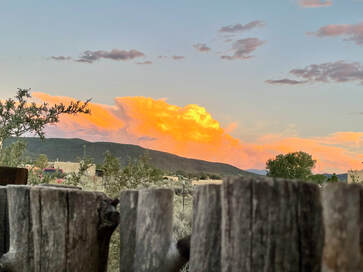 In Northern New Mexico, the wind coming from the West across the mesa gathers and moves the hot air to the East. Clouds form as the air approaches the high Sangre de Cristo and Picuris mountains. This orographic phenomenon repeats itself daily here in summer. Sometimes the clouds cool off enough as they rise and rain wets the dry desert at its feet. I can watch for hours from my porch and writing window at the dramatic sky patterns that play out. From Ocean to Sky The clouds move like waves in an ocean; an ocean of blue sky moving its billowy moisture, until a clap of thunder lets me know its force. I’m surrounded by the colossal forces of nature. There are no high-rises, no freeways weaving over and under each other, no big concrete walls here that give the illusion man is in charge. I feel small and vulnerable among the big skies and tall mountains. This landscape calls for hiding places in rocky canyons, and deep forests; places that can offer shelter from the elements, the bright sun, the downpours, the fierce winds. I have such a hiding place. My new nest, my Nido Nuevo, is a small flat-roofed house that sits unobtrusively among the sagebrush at the end of a cul-de-sac with similar houses sprinkled around on the mesa. A tiny house made of the mud and earth that forms its foundation. A house that keeps me cool in summer, warm in winter, and lets me watch the clouds race by in the big sky outside my windows. A house that not only shelters me, but houses in its surrounding mesa quail families in its brush and ants in dusty perfectly round anthills. We are the low-living creatures of this place. I haven’t seen prairie dogs or chipmunks on my property yet, but it will not surprise me when they make their appearance. A Pilgrimage I feel safe here. And yet, I’m leaving for awhile to challenge myself in nature and feel its force. A long hike on the Pacific Crest trail in the California mountains awaits me. The Pacific Crest trail is a 2650-mile long trail that runs along the mountain crests of California, Oregon and Washington from the Mexican border to Canada. Summer is the time for this pilgrimage; a walk that will remake me, let me rediscover what I’m made of, and learn about the world around me. Nervous anticipation with anxiety over the forces of aging affecting my body, are making me feel vulnerable, and cause restless sleep despite the preparations, despite the training I’ve put my body through. A last pilgrimage on this trail I discovered 10 years ago and have explored and traversed every summer since. A 10-year Journey At age 65 I started small, a 3-day hike near my home in Southern Oregon, then a 3-week hike to cover most of Oregon, then a week to finish the Oregon section. I felt I had gained a sense of the place where I lived. The experience called for more exploration of myself, my stamina, living in nature day in, day out. The John Muir section was next. I finished half of it in a thunderstorm-filled 2 weeks, finding my body rhythm as I climbed high pass after high pass and waded through trail turned river from a suddenly formed cataract. Exhilarated by the high Sierras, Washington state called next. The Washington Cascades are an undulating ocean of mountain ridges with far vistas, steep inclines, berry-filled valleys, towering trees and human sized ferns. My first experience in old-growth forests left me with awe and gratefulness to be a human walking this earth. The desert in Southern California scared me; it was an unfamiliar part of the PCT, a way of life and survival unknown to me. On a sunny April day I stepped away from the Mexican border and found ridges surrounding dry dusty bowls, ridges with rainbows, ridges with a plant world in a super bloom. I fell in love with the desert and lost my fear. I gained respect for the tenacity of plant life. I learned to heed weather warnings as it can snow in the desert. I crawled over icy slopes dropping off into deep ravines. Every front has its back, and the desert shows it in spades. As my body lost its sweat, I fainted and learned to drink electrolytes throughout the day and manage the heat. I sustained a knee injury carrying 4 liters of water between water caches. My body showed what it is capable of as I walked a 100 miles with pain, not knowing I had a stress fracture. Every time I completed a section, I came home with a new sense of self, a deep feeling of connection with the world I live in, a trust in my body and its natural processes that fuel living, creating and forming relationships. The hikes gave me love for life. The hikes gave me hope and trust that things will work out. The Last Leg And so, after a year of transforming my life and moving to the high desert of Northern New Mexico, after a year of horrendous war, mass shootings and divisiveness among political perspectives, I set out to hike and remake myself once more on this, for me, last 150 mile section of the Pacific Crest Trail. I will enter Desolation Wilderness near Tahoe and hike to Tuolumne Meadows in Yosemite park where I entered the John Muir trail so many years ago. Other women will hike with me, women I’ve met through my postings online and my book writing. I’ve cherished the sections of the PCT I’ve done solo: most of Oregon, half of the JMT, the Southern California desert; but I welcome the companionship of others who are discovering themselves as they hike along with me and work off my expertise. I will pass the baton of inspiration and devotion to the natural world to them and hope they will bring others along on their journey of finding themselves one step at a time. The wind is picking up and blowing in through my window. Will the clouds drop their moisture this evening as they rise up the slopes? Will I make it up the looming slopes in California with my heavy pack? Desolation Wilderness with view toward High Sierras, photo courtesy Margie Reynolds Comments and questions are welcome. Sharing is encouraged.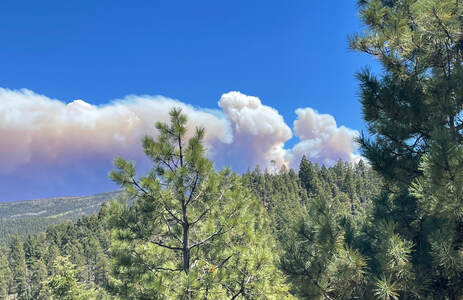 It’s been a traumatic month. Mass shootings, wildfires, and other climate change driven disasters have filled the news. A now endless looking war in Ukraine is taking a second tier for our attention, and price hikes across the globe are a daily struggle, hitting the less privileged the hardest. People are suffering, as the buddhist teachings call it: dukkha or sankhara dukkha, the suffering of conditioned reality. This means having a body and living in the world, goes hand in hand with suffering. My suffering this month was limited to dealing with a price-gauging moving company, ungodly hours for delivering my stuff (what moving company delivers at 9:00 PM?). I developed plantar fasciitis in my effort to train for a section hike this summer (carrying too much weight on difficult terrain). Moving into a new home meant I had to find help to fix things up to my liking. Finding paid help has been a struggle. Waiting for escrow to close the last 4 months paid off. I developed patience and changed my expectations: I didn’t loose my cool. I remained persistent in my problem solving. I found more rewarding things to do, such as arranging my familiar things in my new home; I enjoyed learning about plant life on my little plot of land, as I watered 13 young trees that came with the property, by hand. A broadband company hooked up Wi-Fi before I moved in, and now I can access screen entertainment when I want to escape my daily problems. I’m privileged. And yet, I feel the pain of family experiencing setbacks, friends dealing with health issues, communities grieving as wild fires destroy a way of life, and shooters kill their children and loved ones. Life isn’t fair. I may think I have solutions for the enormous problems in the world, but politicians don’t listen to my solutions. How did money hungry sponsors get to determine what rule makers can and cannot do? Rules that better society but don’t create immediate profit, are a thing of the past. The small steps, a small amount of money for self promotion, grew into big steps and big money to keep people in power. Does Grassley contribute to the betterment of his constituents after 7 terms in office? Doesn’t he know when it’s time to bow out? So how do we live in these trying times? I rely on Buddhist teachings for guidance. One teaching explains how to experience mudhita, joy. You will experience joy if your attention is on whatever is happening right in front of you. If you focus your attention you can respond instead of react, and you can act from a place of wisdom and compassion. Responsiveness generates a sense of joy. Remember how you feel when you hold a door for someone and you get a smile and thank you? That is mudhita. If you pay attention to the surrounding misery, and act in response either by reaching out, or just listening and being present, joy arises. Right action produces joy. We’re all in this together. Separating yourself from the pain and suffering of others goes against the grain of this universe. What happens to another person, animal, or ecosystem happens to us. The effects of climate change on our life should teach us that. Everyone and everything is affected. Try as you might, you cannot escape it. You may think the fires in the Arctic will not affect you when you live in Massachusetts, but you’re wrong; smoke travels and will pollute your air. Warming of permafrost increases carbon in the atmosphere, which will heat our planet even more. The melting of the ice will raise and warm ocean water levels and affect weather, animal migration, food sources and more. I live near a wild fire that destroyed people’s homes and land. These people are now living as evacuees in my town. They need food and shelter. I see what is needed. I can ignore, or I can help. If I ignore, the suffering will continue; if I help, I experience connectedness and joy. It’s a simple equation. I discovered this sense of being connected when I was hiking weeks on end on the trail, carrying my food and belongings in a backpack. Living out in nature, I was affected by weather and terrain; it taught me I’m a minor cog in the wheel of life. Observing the trees taught me how to listen and understand how the forest functions, the snow nourishes, the rocks protect the plants. In the civilized world where I live in a house, I sit with what’s happening around me. I write a letter, advocate for a cause, donate money, employ people who’ve lost everything and are starting over again. Next time it may be me who needs the help. I know I will never be separated from the rest of this world. We can’t escape pain and suffering, but we can diminish suffering by being present, and respond by putting an arm around somebody, by sharing what little we have, by thanking your FedEx delivery man, by speaking up, by refusing to take part in wasteful consumption. You can do much good when you think about each act in your day. Go slow, be one with the cactus people, do less and know that you’re infusing the world with kindness. If that doesn’t bring joy, I don’t know what will. 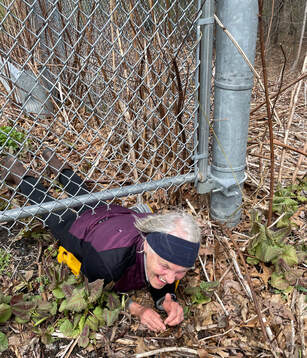 It’s a desperate attempt on my part. I’m crawling on my belly under a chain-link fence cheered on by my grandsons, who with their wiry, small bodies wriggled through the side opening a few minutes ago. We took a - for them -daring leap and veered off the beaten trail, and marched through thickets and dry leaves on a ridge above the dump. “The dump is down there!”, my oldest grandson yells, “I didn’t know this is where we are! If we follow the road through the dump, we’ll get home,” he adds. “Let’s not”, I say, “the dump can be dangerous terrain with chemicals and stuff.” I hear their mother’s voice of caution in my head, “if we can get to the other side of this fence, we can cross the fields.” I had seen a safer route on my GPS. So I must wiggle my bigger body underneath the fence to where we can enter soccer fields on school property, a short way from home. My grandson keeps expressing his amazement over finding known territory in a - for him - wild place. That’s the adventure of going on a walk, I tell him. He asked me earlier as we started our walk why I wanted to walk. After a quarter mile on the familiar trail from his house, he expresses boredom. “You never know what you’ll find”, I tell him. If you walk far enough, boring becomes an adventure. And indeed, the day’s walk becomes adventurous. We follow a small creek near to the groomed woodland trail, move leaves and debris to improve the creek’s flow, come upon an unknown little waterfall, watch skunk cabbage leaves float downstream and over the fall and work on trail finding. When we leave the marked trail again the boys find old deer bones in the dry leaves; a first violet stares up with dark eye markings from the moss. Nature keeps offering surprises. I rip my coat crawling under that fence. A small rip. I scratch my calf on the steel point of the chain link, a bleeding gash, looking worse than it is. Adventure trophies. The real win is the feeling we have inside us, a feeling of excitement, aliveness, newness in days destroyed by routine and order. Raising kids is a hard job. Raising privileged kids is hard because we lace the days with expectations, achievements that need to be met, as the college funds grow in the stock market. The daily routine of eat, sleep, play and learn shave off the individual idiosyncrasies that could spell genius, sense of adventure, and freedom of thought. We groom the children to fit into an affluent society of 2-acre properties, million dollar homes with separate bedrooms, bathrooms, play rooms and offices. The children meet peers with the same privileged life on sports fields, and play flag football, baseball or whatever game the season offers in competitive games. At 5 years old, they already know the rules of the game. They are born into a family that wants the best and follows the rules of the upper class. Feeling stifled by the rules, bored by the affluent sameness, I suggest we pick up garbage for Earth day. A raised parental brow, a yes-vote by the boys because the local township gives out ice-cream for turning in bags of trash picked up along roadways. With gloved hands and bag we set out to find the things people throw out the window of their BMW and Lexus vehicles: soda cans, paper, plastic, a pencil. Even the trash is groomed. A world of comfort and privilege takes the feeling of adventure out of living. I don’t begrudge my grandchildren a privileged life. I wish the best for them. My idea of best though, is living with zest, creativity, newness, and advocacy for the underdog. It means living a life with just enough suffering that it breeds compassion for others; a life that makes you want to learn how to improve things for all people, not just for a privileged corner of the world. My idea of best is when you turn a neighborhood walk into an adventure because you look around, encounter hardship, witness unusual things, and make spontaneous, positive decisions. Is your life feeling stale? Maybe it’s time to shake things up, add newness with its inherit discomfort. Try something you haven’t done before, explore further, reach out to the less privileged. You will be the richer for it.  Her name is “Chooch”, (“tsjoots”), she spells it out for me and says, “that’s Italian slang for a(xx)-hole”. She laces the story of her life of abuse and disappointment with expletives, her face weathered under the woolen hat. Leaning on her cane, she seats herself next to me. “I have to sit this way”, she says as she turns away from me, leaving her left leg outstretched on the grass. She must have something wrong with her hip. Eyes blue, and cracking a smile, she asks me what brings me to the temple. I tell her my story. While we’re chatting, people serve an Indian lunch after morning chants. My conversation with a man across from me ends. He has expressed his doubts about the world, his insecurities about going anywhere besides around town. A large woman with an unusual name mills around with an older Indian man, calling him her “honey” for offering to get her food. I’ve met her a few weeks ago and notice that she is a regular. “This is the only hot meal I get, during the week,” she told me. The perfection of social services Is this the homeless hand-out, I wonder? I see the perfection of a well-off minority helping a struggling minority. A Hindu temple in Northern New Mexico is an unusual sight, and I have questions about its function. For me, visiting the temple is a return to the early 70ties when I was traveling in India. The heart-opening chants, the clanking of bells, the offerings, the pictures of a guru long ago passed away. Now Indian families pay their respects, prostrating themselves in front of a Hanuman statue. White people with matted hair and hippie clothing sit in silent meditation or clap along with the chants. It is a throwback to days long gone. Who maintains this place? Chooch has an answer: the 70ties famous hippies are gone, she says, the current board means nothing, the Indians have taken over and are doing their religious duties, there’s enough money to feed everyone. It sounds perfect! Seeing the perfection of things When I stayed at the ashram of Mahara-ji (the man in the pictures in the temple hall) in India, he told me: “feed people.” Here at this temple they still practice the tradition of handing out Prasad, or blessed food; volunteers prepare food for anyone that comes. A church, a social service, where society fails the poor and the mentally unstable. Perfection? Ram Das said in one of his talks, when we achieve the state of eternal love-joy, and embrace the destruction, suffering and death in this world with empathy, we will see the perfection of things. Perfection in nature I have trouble seeing that things in Ukraine are perfect, and for that matter in Sudan, Jemen, Syria, Afghanistan- do I need to continue? My heart aches, my brain shuts off. I walk to rid myself of my anger, my hopelessness in a greening desert landscape with twisted dry sage bushes and hard rocks. This thirsty ancient land has suffered under the sun, wind, and snow. Gnarly and dry the bushes sprout new green twigs, the rocks are a host to beautifully patterned lichen. Lichen break down the rock into sandy soil that provides shelter to prairie dogs, rabbits and other small critters living in holes under the ground. Big ravens soar over the canyon, finding food and water. Big-horn sheep clamber down the steep ravine to slake their thirst in the river. A balanced eco-system. Perfection! Perfect Opportunity Life is a balancing act. Much goes wrong from the start of life to its fulfillment. Much goes right and life offers beauty, balance, and new creations. A Pasques flower lifts its fuzzy purple head to open its inner white petals. The white reflects the warmth of the sun onto the yellow heart, warming the stamens and attracting bees to this tucked away corner near a rock in the desert. Perfection. I’m between homes I can call my own, but have a comfortable place to live. I can’t do what I intended, but I have time to re-design my life, step out of ruts that no longer serve me. Perfect! Adversity can be an opportunity. The perfection of a pendulum swing I don’t wish the horrid adversity we’re witnessing every day on the news. But the violence in Ukraine offers the Western world an opportunity to do better, to lift the veils of apathy, slough of indulgence and inertia. I am no starry-eyed idealist, but I see the perfection of a pendulum swing. It’s not too late to change direction, and create a better, more balanced world. 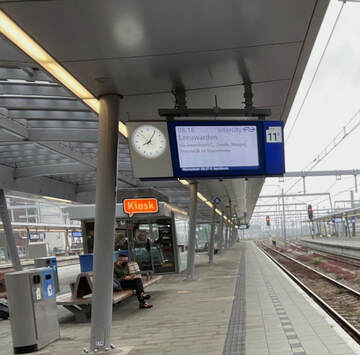 His hand touches the glass of the train window. Through his phone in his other hand, he talks to the woman inside the train - his wife? A child’s hand tries to match his hand from the other side of the window. The station platform is near empty. All passengers have boarded; the train is about to leave. Sending your family to safety when war breaks out, is what we all would do. Saying goodbye to family is a common scene at airports and train stations. Saying goodbye with the knowledge you may never…. I’ve said goodbye to family quite a few times in my life. Young and thinking I was invulnerable, it was easy when I traveled from Holland overland to India. Of course I’d be back. Adventure called. Saying goodbye when I emigrated from Holland to the USA was a more conscious separation. It would be a long time before I saw my family again. The desire to build a new family was stronger; the urge to find a better place to live, fierce . I did see my family again. Privileged as I was and living in a free world, I could travel. After gaining enough financial security, I could travel across the globe yearly. Family and fresh adventures were wrapped in one. My son relocated to the other side of the country. I felt the same pang my mother felt when she let me go to the USA. It wasn’t “never” as she feared, but “rarely” was true for me. My heart ached. The girls left home; not as far. My parents died; my husband passed away. The word “never” became real. My heart aches for this man who is sending his family to safety. What is safety worth if you can’t be among loved ones? The pandemic taught us that safety can be very lonely. I’m used to living alone, far away from family and children. I’ve bridged the gap through travel, long visits, FaceTime calls. Nothing replaces the immediacy of living near each other; being able to touch and catch the look in each other’s eye, unclouded by a screen, or a window. Knowing that, I moved near family again. I left a warm circle of friends, a familiar place I’ve called home for 36 years, a garden that thrived under my watchful eye, hillsides ablaze with the light of sunsets. Never to return. It’s too far for a quick visit. I’m too old to be hopping around on the spur of the moment. NEVER is sinking in, as I feel the new earth I walk on, look at a different mountain view, that doesn’t feel like home yet. Sadness lines my heart, soft, teary, a wobbly feeling. I haven’t sprouted roots to help me feel stable and turn the sadness into energy for living. I practice meditation, I walk. Each hour of sitting in meditation brings me closer to being here. The universe embraces me through each walk I take. Each hour helps me let go of what I had. Never results from change. Change happens in each moment. It helps to witness change. In small increments I am present for the “nevers” in my life. I feel the sadness and sense of freedom that accompanies letting go. The Ukrainian man saying goodbye at the train window, chooses to stay and fight for freedom. He chooses to give his loved ones the freedom of safety. He’s a big-hearted man whose heart will ache for a long time, maybe forever if change won’t let him re-unite with his family. Love is the currency of the heart. Only love will heal this man’s heart. On one of my long hikes in the eastern part of Holland, I passed through what was a concentration camp in WWII, now an open air museum. This is what I saw. We must NEVER let this atrocity repeat itself. 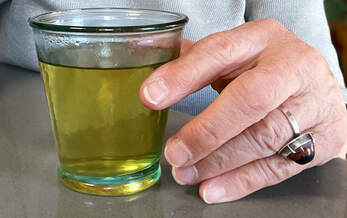 “In the early ‘50s, Paul Reps, who was in his forties, had traveled to Japan en route to visit a respected Zen master in Korea. He went to the passport office to apply for his visa and was politely informed that his request was denied due to the conflict that had just broken out. Reps walked away, and sat down quietly in the waiting area. He reached into his bag, pulled out his thermos, and poured a cup of tea. Drinking his tea, he pulled out a brush and paper upon which he wrote a picture poem. The clerk read the poem, and it brought tears to his eyes. He smiled, bowed with respect, and stamped Reps’ passport for passage to Korea. Reps’ Haiku read: “drinking a bowl of green tea, I stop the war”.” (from a post in “Better Listen” by Steve Stein) Moving toward mindfulness I heard this story during a two-week meditation retreat I just attended. Voluntarily cut off from news and media, I knew the war in Ukraine was brewing. I wondered if the teacher mentioned the story in her evening talk not only to help us double our attentiveness in the moment, but also inform us indirectly that a war had broken out (it had at that point). The next day outside, on my slow, deliberate walk while minding my breath, a pair of neighborhood walkers greeted me with the words: “I won’t walk with you, too slow, like the Ukrainian army”. I knew then that the war had broken out; I could do nothing about it. Back in my hermitage, I watched the water boil for my daily tea, watched my hand lift the kettle, and pour the hot water in the thermos with the tea. I waited, mindful of the urge in my body to multi-task, while making the perfect cup of tea. I poured the tea in a glass. The green color lit up as the light shone through the glass. I sat and sipped the tea, feeling the sensations as the liquid moved down my throat, the bitter taste on my tongue, the wetness of my lips. Loving Kindness Between sits and meditative walks, I made many cups of tea. My concentration grew, my awareness of what was going on in my body/heart/mind increased. Tranquility set in as I loved my body on the cushion. Happiness coursed through me as I moved while walking with open sense doors (eyes, ears, skin). I took in the brilliant sunlight, listened to birdsong, watched the sagebrush hold its own as the snow covered it and the sun uncovered it with its warmth. Discomforts in my body and deep fears in my mind fell away, one sit at a time, one step at a time. In the 2nd week when the teacher guided us to not only love ourselves, but send loving kindness to others, gratitude and warmth I wanted to share filled me. When I watched the first Newshour after the retreat ended, I sat there and cried. My heart was open, I couldn’t shield myself from the suffering I saw. The many cups of tea I drank didn’t stop the war. Creating Peace What was the meaning of Paul Reps’ Haiku? He didn’t stop the Korean war by practicing with his Zen master. Why did the haiku bring tears to the clerk’s eyes? As my mindfulness increased not only when I practiced on the cushion but also when I walked, when I made tea, when I ate, when I turned over to go to sleep (even in my dreams), I let go of the accumulated tension of months of prior stress, I uncovered self love, and love for everyone else. I became an aware human being that felt kindness toward others. I stopped the war inside myself and between myself and others. Paul Reps’ haiku told the clerk, I practice mindfulness, and by doing so I create peace. The Japanese clerk understood this as tea ceremony and practicing mindfulness was part of his cultural heritage. Fear and Power Putin doesn’t practice mindfulness to improve himself as a human being. Putin pays attention to the inner voice of desire for increased power, and his fear of losing that power. As Trump said in an interview with Bob Woodward and Robert Costa on March 31, 2016: “Real power is — I don’t even want to use the word— fear”. During the retreat, I watched fear rise in my mind over an issue that is brewing in my life; I wanted to fight, argue and plan what I would do. Committed to being in retreat, I could do nothing but watch the fear and notice the sensations it caused in my body. As I watched with acceptance, the sensations changed. The image of myself as a girl emerged, a girl taught to be afraid of authorities. I wanted to embrace this little girl and tell her that now is not then. The fear released; stiffness in my back (frozen in fear) let go, and I could move on to the next sensation, and the next and the next. The Moral Balance My mindfulness work doesn’t stop the war. But it changes how I interact with others. Everyone’s mindfulness changes the world as we know it, one act at a time. Your patience with the grocery clerk, the smile you give to the harassed ticket collector in the subway, the words of understanding you offer to the customer service agent at Amazon — mine thanked me, and I could hear him breathe easier as I didn’t get angry when he couldn’t solve my problem that instant —-, it all adds up. As the world comes together to support the victims of Putin’s greed for power, it shows us and him that his actions hang in a moral balance with the rest of the world. As the words from an ancient Buddhists chant say: “May the noble and the not noble have karma as their true property”. Putin will face his karma some day. |
Categories
All
Archives
August 2023
|
Transformation-Travel
|
Contact Us |
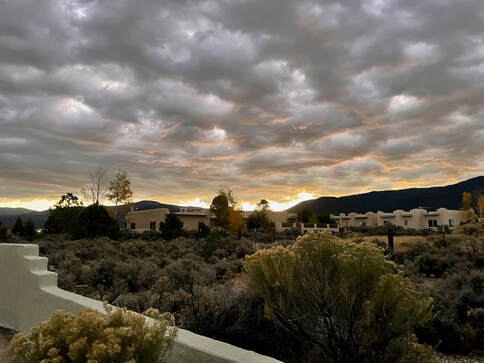
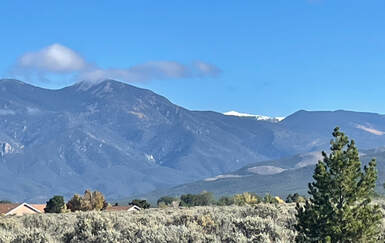
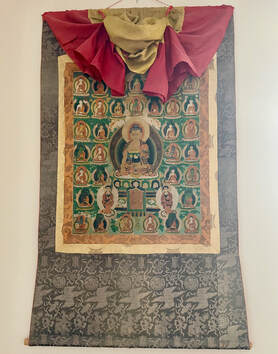
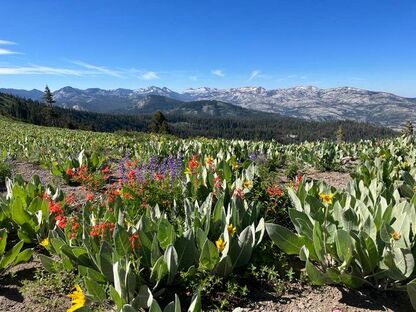
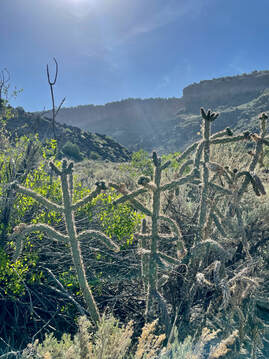
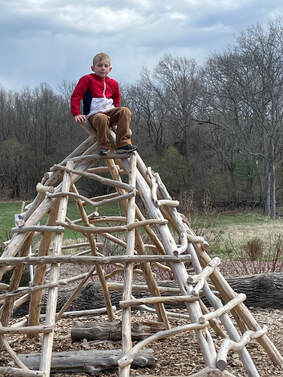
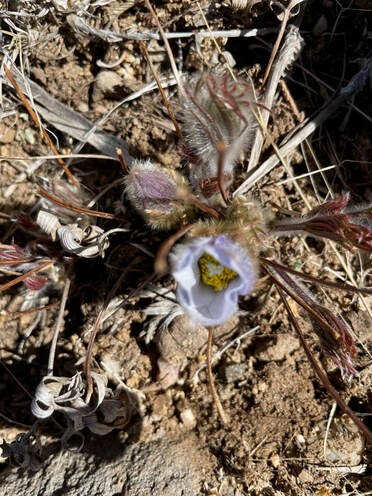


 RSS Feed
RSS Feed